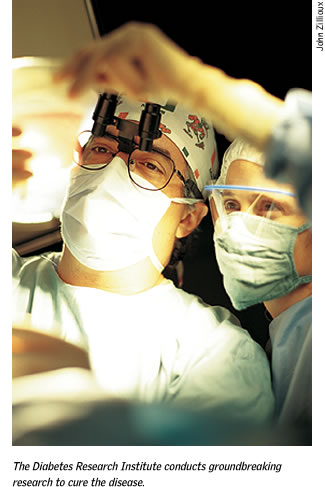 The
Diabetes Research Institute at the Miller School of
Medicine received a $15 million gift from the Diabetes
Research Institute Foundation. The gift was announced
in September by Robert Pearlman, the foundation’s
president and chief executive officer. The
Diabetes Research Institute at the Miller School of
Medicine received a $15 million gift from the Diabetes
Research Institute Foundation. The gift was announced
in September by Robert Pearlman, the foundation’s
president and chief executive officer.
Pearlman was joined by University President
Donna E. Shalala, Senior Vice President for Medical
Affairs
and Miller School Dean Pascal J. Goldschmidt, M.D.,
and Diabetes Research Institute Scientific Director
Camillo Ricordi, M.D.
“The key to unlocking the mystery of this deadly
disease is to continue our research, which would not
be possible
without the generous and steady support of the Diabetes
Research Institute Foundation,” said Shalala. “This
unprecedented 30-year partnership has allowed great
advances toward bringing a solution to those suffering
from the disease today.”
The new gift brings the foundation’s donations
during the University’s Momentum campaign to
$80 million. Since being created in 1971, the foundation
has given about $120 million to the Diabetes Research
Institute.
“We are proud to be able to make this gift and
to grow hand-in-hand with the Diabetes Research Institute,” said
Pearlman. “We never dreamed we would be able
to contribute the initial $50 million, but we are deeply
honored to be able to help move this important institute
from very good to great and know that this gift will
have a direct impact on patients seeking a solution.”
Finding a cure is the overriding mission
of the Diabetes Research Institute, and it is recognized
as a world
leader in cure-focused research. Patients with type
1 diabetes who receive transplants go through a process
where islet cells are isolated from donor pancreases
and are infused into their liver. Once in the liver,
the cells develop a blood supply and begin producing
insulin. But patients still struggle while their
bodies try to reject the new cells.
“This is a fabulous opportunity
for the Miller School of Medicine to make an extraordinary
difference in
diabetes type 1 research,” said Goldschmidt. “This
kind of support is simply unmatched in any place I’ve
been in the U.S. or in the world. We are so fortunate
to have supporters whose deep commitment and imagination
champion our cause to find a cure. The vision of Dr.
Ricordi and his team and the Diabetes Research Institute
Foundation are in perfect synergy.” Ricordi’s research enabled scientists to isolate
insulin-producing cells from the pancreas when he invented
the Ricordi Chamber, the core element of the process.
Next, he developed a way to keep the cells viable long
enough to transport them long distances. Ricordi and
his colleagues have now extended their research efforts
to identify a source of islet cells that is unlimited.
One method involves stem cell research, and the other
involves using animal sources of insulin, such as pig
islets. They are also seeking ways to reduce or eliminate
the need for the anti-rejection drugs transplant recipients
must take.
“I couldn’t be more proud,” said
Ricordi. “Moving
this research from its very beginning stage—the
hypothesis—to now see the first successes in
patients is amazing. But the real heroes in this enterprise
are the patients who have shown such tremendous courage
and determination to beat this disease. But we as doctors
must confront these two major challenges and continue
the fight to find the cure.” |